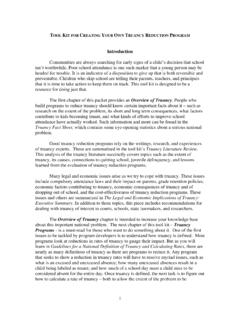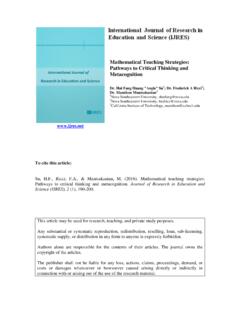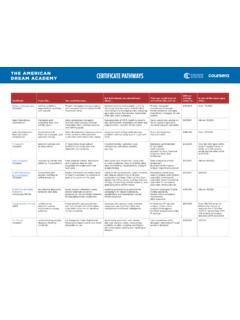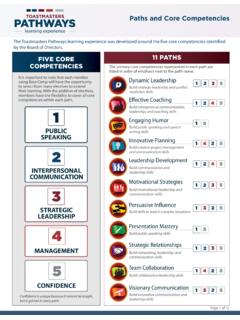Transcription of ALBumin April 2010 - University Health System
1 Page 1 of 5 GUIDELINES FOR USE OF ALBumin Adapted from the original published guidelines developed by the University Hospital Consortium and published in Archives of Internal Medicine, Vol 155, Feb 27, 1995 [Revised 2005 & 2010] Backgound The Consortium guidelines from 1995 addressed 12 indications and often did not recommend the FDA-approved indications as first line therapy. They were presented in an effort to minimize unnecessary use of ALBumin during an extended shortage that even today requires monthly allocations. Many trials have been published since 1995 and revision of UHS guidelines is long overdue. A Drug Usage Evaluation (DUE) performed in May 2009 revealed only 53% of ALBumin use met the current usage criteria. It also showed that 70% of the ALBumin use was from three services: Medicine, Transplant & Cardiothoracic Surgery. Non-protein colloids (hetastarch and dextrans) were offered as first-line, less costly alternatives in the 1995 guidelines & for several indications stated that ALBumin should be reserved for cases where non-protein colloids were contraindicated.
2 However, non-protein colloids have subsequently been implicated in bleeding abnormalities & high-molecular-weight dextrans are no longer available. In addition, the DUE clearly showed that clinicians were not considering non-protein colloids as viable first-line alternatives even for FDA-approved indications. One of the recommendations of the DUE was to remove from the UHS Guidelines any statements that require non-protein colloids be contraindicated before ALBumin can be used. [This was done at P&T meeting in February] ALBumin is available in 5% and 25% strengths. 25 g is osmotically equivalent to about 500 mL of fresh frozen plasma. In general, 5% is intended to restore plasma volume while the 25% will raise oncotic pressure (Micromedex 2010) The debate over effectiveness of crystalloids vs. non-protein colloids vs. ALBumin continues. A Cochrane review from 2009 -- Colloids vs Crystalloids for fluid resuscitation in critically ill patients (Review) -- by Perel concludes: There is no evidence from [randomized-controlled trials] that resuscitation with colloids reduces the risk of death, compared to resuscitation with crystalloids, in patients with trauma, burns or following Clinical studies have shown that colloids & crystalloids have different effects on a range of important physiologic parameters.
3 Because of these differences, all cause mortality is arguably the most clinically relevant outcome The choice of fluid has considerable cost implications. Volume replacement with colloids is considerably more expensive than with crystalloids. See last page for UHS cost comparisons which underline the need for judicious use of ALBumin `Indication Guideline Hemorrhagic shock (Hypovolemic) Crystalloids should be considered the initial resuscitation fluid of choice; colloids are appropriate for resuscitation in conjunction with crystalloids when blood products are not immediately available; Once the diagnosis of severe hypovolemia with or without shock is established, treatment is centered on rapid correction of the intravascular fluid deficit via crystalloid infusion; red blood cells should be used if there is ongoing hemorrhage or severe anemia. There are no strong data to support the routine use of colloid-based solutions, including ALBumin , in the management of severe hypovolemia.
4 (UpToDate 2010) Nonhemorrhagic (Maldistributive) Shock Crystalloids should be considered first-line therapy; Clinical trials have failed to consistently demonstrate a difference between colloid & crystalloid in the treatment of septic a sufficient quantity of IV fluids rapidly & targeting appropriate goals are more important than the type of fluid (Schmidt, et al UpToDate 2010) Hepatic resection Crystalloid use is recommended to maintain effective circulating volume following major (>40%) hepatic resection; the use of hetastarch/dextran and ALBumin is also appropriate, depending on the function of the residual liver and hemodynamic status Thermal injury (Hypovolemia) Crystalloid solutions should be used for initial fluid resuscitation (within the first 24 hours); colloids should be administered in conjunction with crystalloids if all of the following are true: 1. Burns cover > 50% of the patients body surface; 2. At least 24 hours have passed since the burn occurred; 3.
5 Crystalloid therapy has failed to correct hypovolemia. An FDA-approved indication in adults Page 2 of 5 Indication Guideline Cerebral ischemia or hemorrhage In the Neurosurgical ICU patient, crystalloids & colloids (primarily NS & ALBumin ) may be used to maintain normovolemia or even hypervolemia as part of triple H therapy (hypertension, hypervolemia, hemodilution) as follows: o For aneurysmal subarachnoid hemorrhage total fluids should be adjusted to maintain target CVP of 6 to 8 to decrease risk of vasospasm If delayed vasospasm occurs, hypervolemia should be induced to maintain CVP goal of 8 to 12 o For acute ischemic stroke or TIA if there is evidence of flow failure o Dose: 5% ALBumin , 250 mL bolus every 2 4 hours PRN CVP goal; adjust rate of crystalloids by 25% if patient requires frequent ALBumin doses Patients with elevated hematocrit levels on admission should receive crystalloid solutions to increase intravascular volume, creating a state of hypervolemia and hemodilution (hematocrit levels of approximately 30% to maximize cerebral perfusion).
6 Nutritional intervention ALBumin should not be used as a supplemental source of protein calories in patients requiring nutritional intervention. However, patients with diarrhea associated with enteral feeding intolerance may benefit from the administration of ALBumin if all the following conditions are met: 1. Significant diarrhea (> 2 liters per day) occurs; 2. Serum ALBumin is < g/dl; 3. Continued diarrhea occurs despite trial of short-chain peptide and elemental formulas; 4. Other causes of diarrhea have been considered and ruled out. Cardiac surgery UHS Guidelines Updated in 2005 Guidelines for ALBumin Use for Volume Expansion by Cardiothoracic Surgery; submitted by A. J. Carpenter, MD, PhD, Director, Cardiothoracic Surgery; Approved by P&T Committee in March 2005 Patients undergoing cardiopulmonary bypass have marked dilution of intravascular colloid oncotic pressure During the early postoperative period, these patients typically require significant volume replacement due to peripheral vasodilation The best volume expander in this setting is ALBumin , and it is essential that the ALBumin be immediately available when needed Guidelines for the use of ALBumin in the post-cardiopulmonary bypass patient are as follows: 1.
7 Replace volume as clinically indicated with 5% ALBumin given through a fluid warmer during the early post-operative period (up to 3 hours) 2. If large volumes are required, change to normal saline after 1500 mL of ALBumin have been given It is essential that ALBumin be in the PYXIS with over-ride authorization in order to have the fluid immediately available Hyper-bilirubinemia of the newborn An FDA-approved indication for 25% ALBumin According to Micromedex, evidence is inconclusive Should not be administered in conjunction with phototherapy, nor should it be used prior to exchange transfusion. It has been used with mixed results as an adjuvant to exchange transfusions and should be administered only with concurrent transfusion of blood. Crystalloids & non-protein colloids do not have bilirubin-binding properties and should not be considered as alternatives to ALBumin . Acute Nephropathy, Nephrosis, Nephrotic syndrome & subsequent hypoalbuminemia Short-term ALBumin use, in conjunction with diuretic therapy, is appropriate for patients with acute, severe peripheral or pulmonary edema who have failed diuretic therapy Although an FDA-approved indication for 25% ALBumin for acute situations, it is ineffective in chronic conditions (Micromedex 2010) Review of clinical studies suggests lack of benefit if hypoalbuminemia is caused by inadequate production, excessive catabolism or proteinuria (Micromedex 2010) While giving 25% ALBumin to raise oncotic pressure can result in an increase of sodium excretion & lead to resolution of edema, this response is not seen in all patients or even in the same patient on different occasions.
8 (UpToDate 2010) Page 3 of 5 Indication Guideline Ascites, Cirrhosis, Paracentesis, Spontaneous Bacterial peritonitis & Hepatorenal Syndrome Ascites removal of < 4 liters: Crystalloids should be considered the solution of choice to prevent complications such as reduced effective plasma volume, renal dysfunction, etc. Ascites removal of > 4 liters: Consider ALBumin for the prevention of complications. May use 6 to 8 g of ALBumin for each liter of ascitic fluid removed (UpToDate 2010) Management of spontaneous bacterial peritonitis (SBP) & prevention of hepato-renal syndrome (HRS): in patients with cirrhosis and SBP, treatment with intravenous ALBumin in addition to an antibiotic reduces the incidence of renal impairment and death in comparison with treatment with an antibiotic alone. (N Engl J Med 1999; 341:403-9.); patients with: o ascitic fluid PMN counts 250 cells/mm3 ( X 109/L) o clinical suspicion of SBP, o a serum creatinine >1 mg/dL o blood urea nitrogen >30 mg/dL, or o total bilirubin >4 mg/dL should receive g ALBumin /kg body weight within 6 hours of detection and g/kg on day three.
9 (UpToDate 2010 & Gut 2007; 56:1310-1318) Diagnosis of HRS: one of the criteria in making a diagnosis of HRS includes lack of improvement in renal function after discontinuation of diuretics and initiation of volume expansion with an ALBumin infusion of 1 g/kg (up to 100 g) daily for 2 consecutive days. (UpToDate 2010) Treatment of Type I HRS: ALBumin infusion plus administration of vasoactive drugs such as octreotide and midodrine should be considered (UpToDate 2010). Dose recommended by International Ascites Club (Gut 2007; 56:1310-1318) is 1 g/kg (max of 100 g) followed by 20 to 40 g/day. (available as 25 g/100 mL bottles). In addition to references mentioned above, see also American Academy for the Study of Liver Diseases (AASLD) Practice Guidelines: Management of Adult Patients with Ascites Due to Cirrhosis: An Update; Runyon, Hepatology 2009;Vol 49, No 6:2087-2107. These guidelines offer a Class and Level of Evidence with each recommendation and are posted on the UHS Clinical Intranet under ALBumin Use.
10 Organ transplantation ALBumin &/or non-protein colloid administration have not been demonstrated conclusively effective during &/or after renal transplantation surgery. ALBumin may be useful for postoperative liver transplant patients in the control of ascites and peripheral edema if all of the conditions are met: 1. Serum ALBumin is < g/dl; 2. Pulmonary capillary wedge pressure is < 12 mm Hg; 3. Hematocrit is > 30% In these cases, ALBumin may also be used to replace ascitic fluid lost through drainage catheters following liver transplantation. Plasmapheresis ALBumin , in conjunction with large-volume plasma exchange, is appropriate. Large-volume plasma exchange is defined as > 20 mL/kg in one session, or more than 20 mL/kg in repeated sessions. Crystalloid solutions and ALBumin /crystalloid combination should be considered as cost-effective alternatives for smaller volume exchanges. Acute Respiratory Distress Syndrome (ARDS) Fluid restriction is appropriate for patients with hemodynamically stable Acute Lung Injury (ALI)/ARDS); the combination of colloids (25% ALBumin ) and diuretics may be considered in patients with hypo-oncotic ALI/ARDS.








